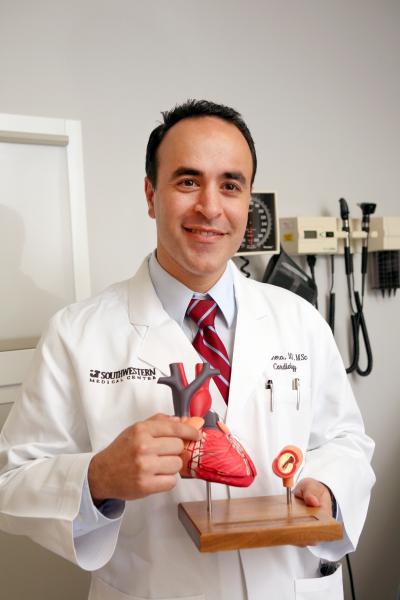DALLAS—Federal medicine played a crucial role in the development of a new online tool to better predict which middle-aged adults are at the greatest risk of having acute myocardial infarction or stroke over the next decade.
The Astronaut Cardiovascular Health and Risk Modification (Astro-CHARM) calculator, was developed by the National Space Biomedical Research Institute in conjunction with a team led by University of Texas Southwestern researchers and including contributions from the Boston VA Healthcare System. Results of the study were published recently in the journal Circulation.
Astro-CHARM is touted as the first integrated ASCVD risk calculator, including traditional risk factors from existing tools, as well as high-sensitivity C-reactive protein (hsCRP), coronary artery calcium and family history of MI. Participant level data was derived from three large, population-based cohorts: the Prospective Army Coronary Calcium Project (PACC). the Multi-Ethnic Study of Atherosclerosis (MESA) and the Dallas Heart Study (DHS). Participants in the Framingham Heart Study (FHS) Offspring and Third Generation cohorts were used for an external validation cohort.
“We found that the Astro-CHARM tool significantly improves cardiovascular risk prediction. It will be an important step forward in decision-making for preventive treatments in the general population for people in midlife,” said first author Amit Khera, MD, of UT Southwestern. “Cardiovascular risk assessment can also be critical in younger populations, particularly those in high-risk occupations.”

The study was initially launched by NASA to improve cardiovascular risk prediction for astronauts, who are predominantly middle-aged men and women.
The researchers pointed out that, while coronary artery calcium (CAC) is a valuable new risk indicator for atherosclerotic cardiovascular disease (ASCVD), no available risk prediction tool existed that integrated traditional risk factors and CAC.
Their goal was to develop a CAC ASCVD risk tool for younger people in the general population, ages 40-65 without prior CVD. To do that, they used the three population-based cohorts, including the Army project.
The study team developed models incorporating age, sex, systolic blood pressure, total and HDL cholesterol, smoking, diabetes, hypertension treatment, family history of MI, high-sensitivity CRP (hs-CRP) and CAC scores (Astro-CHARM model) as dependent variables. The outcome was designated as ASCVD (i.e., nonfatal/fatal MI or stroke).
Performance of the tool was assessed internally, then validated externally in the fourth, Framingham, cohort.
The derivation study included 7,382 adults with mean age of 51, 45% female, and 55% nonwhite. The median CAC was 0 (25-75th [0,9]), and 304 ASCVD events occurred in median 10.9 years of follow-up.
Researchers reported that the c-statistic was 0.784 for the risk factor model and 0.817 for Astro-CHARM (p<0.0001).
“Compared with the risk factor model, the Astro-CHARM model resulted in integrated discrimination improvement (IDI=0.0252), as well as net reclassification improvement (NRI=0.121, p<0.0001),” they determined. “The Astro-CHARM model demonstrated good discrimination (c=0.78) and calibration (Nam-D’Agostino χ2:13.2, p=0.16) in the validation cohort (n=2057; 55 events).”
Mobile App Available
As a result, the study team developed a mobile application and Web-based tool—http://astrocharm.org/—to promote application of the new tool.
“The Astro-CHARM tool is the first integrated ASCVD risk calculator to incorporate risk factors, including hs-CRP and family history, and CAC data,” study authors wrote. “It improves risk prediction compared with traditional risk factor equations and could be useful in risk-based decision making for CV disease prevention in the middle-aged general population.”
“This study is a perfect example of how NASA (and NSBRI) sponsored research helps both astronauts and the general population on Earth,” emphasized senior author Benjamin Levine, MD, of UT Southwestern. “The study was inspired by a critical question asked by flight surgeons and answered quickly by a partnership with academia.”
An expert analysis published online by the American College of Cardiology noted that the 2013 ACC/AHA Guidelines on the Assessment of Cardiovascular Risk recommended using the Pooled Cohort Equations (PCE) to predict 10-year risk of a first ASCVD event. The concern, however, is that the PCE—which includes variables such as age, total cholesterol, high density lipoprotein (HDL) cholesterol, systolic blood pressure, diabetes and current smoking status—can overestimate risk in other races/ethnicities and in populations with less social deprivation.
In terms of including CAC score, the ACC analysis pointed to MESA, where investigators developed a risk score integrating that factor. They caution, however, that MESA only predicts coronary heart disease risk and does not include stroke. The authors also question the age range of the cohort, 45-85.
“In summary,” the analysis concluded, “Astro-CHARM provides a new risk prediction model, intended for a young, relatively healthy population, with unique incorporation of CAC, hsCRP and family history of MI. The Astro-CHARM model appears to increase precision in risk assessment and thereby has the potential to improve shared decision-making regarding initiation of preventive medications. As the global population continues to have growing risk factors for the development of atherosclerosis, accurate risk estimation will become increasingly more important. Models such as Astro-CHARM will likely provide an advantage in targeting individuals for earlier and more appropriate medication initiation.”
1. Khera A, Budoff MJ, O’Donnell CJ, Ayers CA, et. al. The Astronaut Cardiovascular Health and Risk Modification (Astro-CHARM) Coronary Calcium Atherosclerotic Cardiovascular Disease Risk Calculator. 30 Jul 2018 Circulation. 2018;0:CIRCULATIONAHA.118.033505
2. Mihnas A, Blumenthal RS, Martin SS. Astro-CHARM, the First 10-year ASCVD Risk Estimator Incorporating Coronary Calcium. American College of Cardiology. https://www.acc.org/latest-in-cardiology/articles/2018/08/07/08/22/astro-charm-the-first-10-year-ascvd-risk-estimator-incorporating-coronary-calcium (accessed August 8, 2018).
